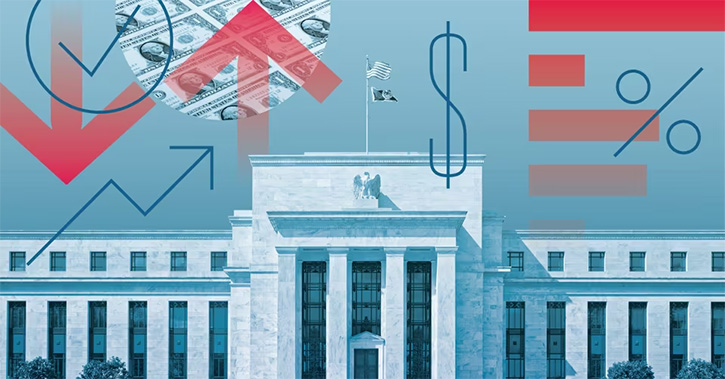
The Federal Reserve has cut interest rates for the first time in more than a decade, effectively putting monetary policy into reverse after raising interest rates four times in 2018.
The move, which cuts rates to within a 2-2.25% range, had been widely anticipated by financial markets, which have been pushed to record highs in recent weeks in expectation that the world’s most influential central bank would start loosening monetary policy.
The Dow Jones, S&P 500 and Nasdaq have all hit record highs this month, helped by strong earnings, especially from tech companies, but investor sentiment has taken been lifted worldwide by the Fed’s about-turn on interest rates.
“As the assumption of accommodative monetary policy has been critical for equity gains, the outcome of this meeting is likely to determine equity sentiment for the next few months,” says Edward Park, deputy chief investment officer at Brooks Macdonald.
Tilney’s Jason Hollands says the timing of this cut is unusual, because they usually occur after stock markets have fallen in anticipation of weaker economic growth ahead. He notes a parallel with July 1995, when the Fed cut rates as the market surged: “Following the cut, the market soared ever higher, with the S&P 500 delivering a total return of 37.6% in 1995 - it was the best calendar year return recorded in the last 50 years and one which was followed by four successive years of stellar returns ranging from 21% to 33% but which was followed by the bursting of the dot com bubble in 2000.”
Indeed, Holland warns, thatthere is a risk that the Fed may be about to stoke the next equity market bubble. Still, the unresolved issues over trade could rein in the market’s animal spirits, he says.
Why Cut When the Economy is Doing Well?
The Fed raised rates in March, June, September and December 2018, and had been expected to continue raising rates this year, albeit at a slower pace. By June 2019, bond, stock and currency markets had switched from expecting further rate rises this year to pricing in three or four cuts.
The US economy, which has been racing along since Trump was elected, is still in rude health, so why is the Fed getting ready to cut? Second quarter growth was 2.1% higher on an annualised basis, compared with a rise of 3.1% in the first tree months of the year. But this is hardly a slowdown in the context of the anaemic global economy. Recent jobs numbers were also better than expected: 224,000 jobs were added in June, against forecasts of 160,000.
Morningstar analyst Eric Compton says that if lower rates lead to a stronger economy, then this strategy could be better than waiting for there to be a recession before making the cut. "There is a big difference between going to zero for the Federal Funds Rate for more than five years (which is what we did last time) versus having a few interest rate cuts, which will eventually reverse in a couple of years," he adds.
Brooks Macdonald’s Park agrees that a July rate cut could be seen as an “insurance cut”, one that anticipates the risks ahead rather than reacting to events. This would be a one-off or part of two cuts this year, rather than reversing all of 2018’s hikes.
The Fed’s move put paid to the idea that the world’s central banks are all moving towards “normalising” interest rates, but just at different speeds. The European Central Bank last week said it was ready to re-start quantitative easing (QE), having stopped buying bonds in December 2018. Unlike the Federal Reserve, however, the ECB doesn’t have much room to cut: its main lending rate is 0%, its marginal lending facility is at 0.25% and its overnight deposit rate is -0.4%.
The Bank of England raised interest rates to 0.75% in August 2018 but with Brexit looming and economic uncertainty still high, Governor Mark Carney is not ruling out a rate cut in the event of a no-deal Brexit. The chances of that happening have increased with the change of Prime Minister from Theresa May to Boris Johnson, who is keen to drive a hard bargain with EU negotiators.



























